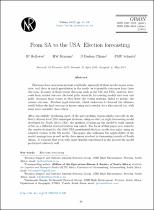JavaScript is disabled for your browser. Some features of this site may not work without it.
- ResearchSpace
- →
- Research Publications/Outputs
- →
- Journal Articles
- →
- View Item
| dc.contributor.author |
Holloway, Jennifer P

|
|
| dc.contributor.author |
Ittmann, HW

|
|
| dc.contributor.author |
Dudeni-Tlhone, Nontembeko

|
|
| dc.contributor.author |
Schmitz, P

|
|
| dc.date.accessioned | 2019-01-29T08:01:37Z | |
| dc.date.available | 2019-01-29T08:01:37Z | |
| dc.date.issued | 2018 | |
| dc.identifier.citation | Holloway, J.P. et al. 2018. From SA to the USA: Election forecasting. ORiON, vol. 34(2): 83-106 | en_US |
| dc.identifier.issn | 0529-191X | |
| dc.identifier.issn | 2224-0004 | |
| dc.identifier.uri | https://www.ajol.info/index.php/orion/article/view/181992 | |
| dc.identifier.uri | http://hdl.handle.net/10204/10649 | |
| dc.description | Article published in ORiON, vol. 34(2): 83-106 | en_US |
| dc.description.abstract | Elections draw enormous interest worldwide, especially if these involve major countries, and there is much speculation in the media as to possible outcomes from these elections. In many of these recent elections, such as the UK and USA, however, forecasts from market surveys, electoral polls, scientific forecasting models and even exit polls, obtained from voters as they leave the voting stations, failed to predict the correct outcome. Election night forecasts, which endeavour to forecast the ultimate result before the final outcome is known using early results, were also carried out, with some more accurate than others. After successfully predicting most of the metropolitan region results correctly in the South African local 2016 municipal elections, using an election night forecasting model developed for South Africa (SA), the question of adapting the model to work outside of SA on a different electoral system was raised. The focus of this paper is to describe the results obtained for the 2016 USA presidential election, on election night, using an adapted version of the SA model. This paper also addresses the applicability of the model assumptions as well as the data issues involved in forecasting outside of South Africa. It is shown that even with many hurdles experienced in the process the model performed relatively well. | en_US |
| dc.language.iso | en | en_US |
| dc.publisher | AJOL | en_US |
| dc.relation.ispartofseries | Worklist;19924 | |
| dc.subject | Election forecasting | en_US |
| dc.title | From SA to the USA: Election forecasting | en_US |
| dc.type | Article | en_US |
| dc.identifier.apacitation | Holloway, J. P., Ittmann, H., Dudeni-Tlhone, N., & Schmitz, P. (2018). From SA to the USA: Election forecasting. http://hdl.handle.net/10204/10649 | en_ZA |
| dc.identifier.chicagocitation | Holloway, Jennifer P, HW Ittmann, Nontembeko Dudeni-Tlhone, and P Schmitz "From SA to the USA: Election forecasting." (2018) http://hdl.handle.net/10204/10649 | en_ZA |
| dc.identifier.vancouvercitation | Holloway JP, Ittmann H, Dudeni-Tlhone N, Schmitz P. From SA to the USA: Election forecasting. 2018; http://hdl.handle.net/10204/10649. | en_ZA |
| dc.identifier.ris | TY - Article AU - Holloway, Jennifer P AU - Ittmann, HW AU - Dudeni-Tlhone, Nontembeko AU - Schmitz, P AB - Elections draw enormous interest worldwide, especially if these involve major countries, and there is much speculation in the media as to possible outcomes from these elections. In many of these recent elections, such as the UK and USA, however, forecasts from market surveys, electoral polls, scientific forecasting models and even exit polls, obtained from voters as they leave the voting stations, failed to predict the correct outcome. Election night forecasts, which endeavour to forecast the ultimate result before the final outcome is known using early results, were also carried out, with some more accurate than others. After successfully predicting most of the metropolitan region results correctly in the South African local 2016 municipal elections, using an election night forecasting model developed for South Africa (SA), the question of adapting the model to work outside of SA on a different electoral system was raised. The focus of this paper is to describe the results obtained for the 2016 USA presidential election, on election night, using an adapted version of the SA model. This paper also addresses the applicability of the model assumptions as well as the data issues involved in forecasting outside of South Africa. It is shown that even with many hurdles experienced in the process the model performed relatively well. DA - 2018 DB - ResearchSpace DP - CSIR KW - Election forecasting LK - https://researchspace.csir.co.za PY - 2018 SM - 0529-191X SM - 2224-0004 T1 - From SA to the USA: Election forecasting TI - From SA to the USA: Election forecasting UR - http://hdl.handle.net/10204/10649 ER - | en_ZA |






